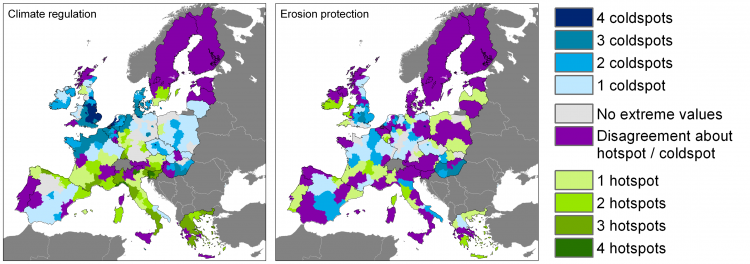
Several EU and global scale policy initiatives depend on accurate and reliable maps of ecosystem service provision for successful implementation. Many methods for mapping ecosystem services have been developed over the past years. Few of these mapping studies are able to provide insight in the accuracy and reliability of the output maps. In a joint project by researchers from the EU project CONNECT, OPERAs, OPENNES and VOLANTE, a systematic comparison of ecosystem service maps was performed at the EU scale. Such a systematic map comparison provides insight in the uncertainty on ecosystem service provision, but does not tell if the maps are accurate.
All maps included in this study originate from well-established methods based on solid process or empirical understanding. Nevertheless, only maps of climate regulation were reasonably similar. For erosion protection, there were no regions where all analyzed maps agree on the existence of a hotspot of provision of the service. For the other ecosystem services assessed (pollination, recreation, flood regulation) there was some agreement among the analyzed maps. Differences among the maps were caused by differences in indicator definition, level of process understanding, mapping aim, data sources and methodology.
To quantify the accuracy of the maps, validation with independent data should be performed. However, monitoring of ecosystem services is often not possible or available, limiting a full validation. Many indicators for environmental issues exist that tell something about ecosystem service provision, but due to the differences in indicator definition, they are not comparable with modelled ecosystem service maps. Consequently, there are no accurate measures for ecosystem service map quality.
The large differences between ecosystem service maps have implications for policies targeting at ecosystem services. First, policies should clearly specify their target of interest to ensure that indicators on ecosystem services exactly fit this target and to minimize the risk of inconsistencies. Second, there is a need for independent validation data on ecosystem services. Third, a variety of ecosystem service maps from different sources could be applied to provide insight in the uncertainty margins of ecosystem service provision.
Reference: Schulp CJE, Burkhard B, Maes J, Van Vliet J, Verburg PH (2014) Uncertainties in Ecosystem Service Maps: A Comparison on the European Scale. PLoS ONE 9(10): e109643. doi:10.1371/journal.pone.0109643.
Link to paper: http://www.plosone.org/article/info%3Adoi%2F10.1371%2Fjournal.pone.0109643
